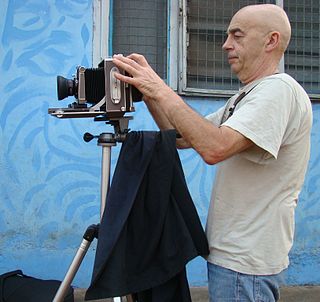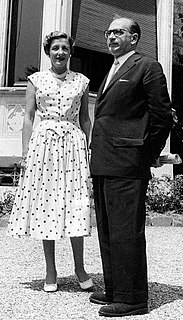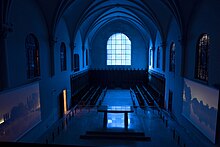The Prix Nadar is an annual prize awarded for a photography book edited in France. The prize was created in 1955 by Association Gens d'Images and is awarded by a jury of photojournalists and publishing experts.

Fouad Laroui is a Moroccan economist and writer, born in Oujda, Morocco. After his studies at the Lycée Lyautey (Casablanca), he joined the prestigious École Nationale des Ponts et Chaussées, where he studied engineering. After working shortly for the Office Cherifien des Phosphates company in Khouribga (Morocco), he moved to the United Kingdom where he spent several years in Cambridge and York. Later he obtained a PhD in economics and moved to Amsterdam where he started his career as a writer. He has published about twenty books between novels, collections of short stories and essays and two collections of poetry in Dutch. He has won several literary prizes, amongst which the Prix Goncourt de la nouvelle, the Prix Jean-Giono and the Grande Médaille de la littérature de l'Académie française.
Through his artistic career, Jean-Christian Bourcart collected unsold wedding pictures, photographed in brothels and S&M cubs, photographed New Yorkers stuck in traffic jams, projected pictures of Iraqi victims on American houses, churches and supermarkets, wrote and published his autobiography and documented lengthy the city of Camden, NJ, one of the poorest and most dangerous city in the USA. He also directed two fiction feature movies, the first one during the war in Bosnia, the second, a sci-fi thriller in New York art world, starring the awards-winner Elodie Bouchez. He is also an active video filmmaker. Nine books about his work have been published. He has been teaching and conducting workshops all along his career. In 2021, all his archives were deposited at the musée Nicephore Niepce in Chalon-sur-Saône in France.

Guy Hersant is a French photographer.

Jean-Francois Campos is a French photographer. His work has been exhibited internationally in numerous galleries and museums, such as the International Center of Photography in New York as well as the Centre national de la photographie in Paris. After an esteemed career as an Agence Vu photojournalist, beginning in Berlin during the fall of the Berlin wall, and a long term collaboration with the French daily newspaper Libération, Jean-Francois Campos turned to fashion and portrait photography in 2006. Jean-Francois has since created numerous award-winning campaigns for clients such as Dior, Louis Vuitton, Shiseido, Celine, Van Cleef & Arpels, and LVMH; and has directed commercials for the likes of Secours Populaire, Mobalpa, and Links of London. Jean-François has collaborated to many international publications such as ELLE Magazine, Town & Country Magazine, Le Monde, and V Magazine.
Bogdan Konopka was a Polish photographer and art critic, who began taking photographs in the mid-1970s. Born in Dynów, Poland he moved to France in 1989. In 1998 he was awarded the Grand Prix de la Ville de Vevey in the European Photo Competition. Receiver of numerous scholarships e.g. Pro Helvetia, the City of Paris (1994), the French Embassy in Beijing (2005), the French Cultural Institute in Romania and Belarus. Author of the famous exhibition Paris en gris (2000) at the Polish Institute in Paris and The Invisible City (2003) at the Centre Pompidou. Bogdan Konopka preferred to work primarily on large format view camera.
Diana Lui is a Franco-Belgian artist, photographer and filmmaker of Chinese origin. Diana Lui is best known for her large format photographic portraits of today's growing hybrid generation of multicultural and multiethnic individuals.

Thomas Devaux, born in 1980 in Marcq-en-Barœul (North), is an artistic photographer from France. He lives and works in Paris.

Robert Delpire was an art publisher, editor, curator, film producer and graphic designer who lived and worked in Paris. He predominantly concerned himself with documentary photography, influenced by his interest in anthropology.

Lucie Faure, néeMeyer was a French woman of letters, novelist and literary review director.
Laurence Aëgerter is a French artist, resident of Amsterdam and Marseille. She works with photography, artist books and projects in public space. In her artistic research, Aëgerter often uses existing images or text material, creating alternatives of historical and contemporary cultural products. In her award-winning 2016 work, Photographic Treatment, Aëgerter sought to engage and connect with individuals with dementia through the pairing of visually similar yet distinct photographs.
Quentin Bajac is a French museum curator and art historian specialising in the history of photography. He is the director of the Galerie nationale du Jeu de Paume in Paris.
This article describes significant photography events in 2019.
This article contains significant photo events in 2018.

Lionel Duroy de Suduiraut is a French writer and journalist born in Bizerte (Tunisia) into an impoverished family of aristocratic origin who long shared extreme right-wing ideas. His youth in this environment left a profound mark on him and was the breeding ground for many of his books. . Lionel Duroy was first a delivery man, a courier, a worker, then a journalist at Libération and at L'événement du jeudi. Since the publication of his first novel in 1990, he has devoted himself entirely to writing novels with an essentially autobiographical content. He is happy to talk about his mother, the family trauma linked to his father's war wounds and the legal expulsion of his family from their home in 1955 - following a lack of solidarity from the rest of the family.

Didier Ben Loulou, is a Franco-Israeli photographer.
Mauren Brodbeck is a Swiss contemporary artist.
La Recherche photographique: histoire-esthétique was a specialised peer-reviewed bi-annual French journal, published from September 1986 to spring 1997, and edited by Paris Audiovisuel and the University of Paris 8.
Les Cahiers de la photographie, published between 1981 and 1994 was a French magazine devoted to photography with the goal of promoting criticism of contemporary photography.
Youqine Lefèvre, is a Belgian photographer and photojournalist.








